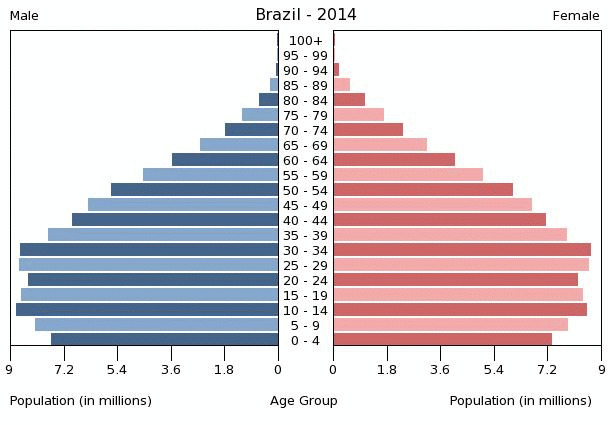
POPULATION OF BRAZIL
The current population of Brazil is 204,213,498 as of April 17th, 2016.
Brazil's population makes up 2.83 of the world's population.
The majority of people live within 300 kilometers of the coast. The Amazon Basin has almost zero population.
In 2014, the CBR was 14.72 births per 1,000 people. Since 2000, the CBR has seemed to steadily decline, except for a major spike in 2007-2008. It then steadily declinedd and dropped sharply from 2012-2014. If this pattern remains the same, we should see another increase in a little over five years.
Brazil's CDR was 6.54 deaths per 1,000 people in 2014. In the year 2002, the death rate drastically decreased and has basically remained the same in the past decade. I see no reason that this patter should not continue.
In 2015, the NIR was valued at 9.07. This was down 13.39% since 2010. The NIR has been on the decline since 1958.
The TFR of Brazil was 1.79 children per woman as of 2014. Since the year 2000, the fertility rate has declined. However, in 2007, it sharply increased, then basically plateued until it took a sharp drop from 2011-2012 where it remained the same or slowly declined. Global fertility rates are in general decline.
Current Population Pyramid of Brazil
A population pyramid illustrates the age and sex structure of a country's population.
The current male population is 103,015,943 or 49.2%.
The current female population is 106,385,162 or 50.8%
There have been 922,822 births this year and 369,008 deaths.
During 2016, the population of Brazil is projected to increase by 1,900,499 people and by the beginning of 2017, it will reach 210,746,573. Births will outnumber deaths by 1,896,322. If external migration stays on the same level, then the population will increase 4,177 just due to migration.
The age structure of Brazil is as follows:
26.3% of the population is under 15 years of age.
67% of the population is between the ages of 15-64.
6.7% of the population is over 65 years of age.
The dependency ration of Brazil is 49.2%. This generally includes people under 15 years of age or over 65. This rate is fairly low. This means the pressure on the working population to provide for their dependents is low.
DTM of Brazil
Brazil is in stage four of the demographic transition model.
(population.education.org)
This means that the birth and death rates are low. This can usually be attributed to strong economies, highly educated citizens, ample healthcare, and the migration of people from rural communities to cities.
en.m.wikipedia.org





